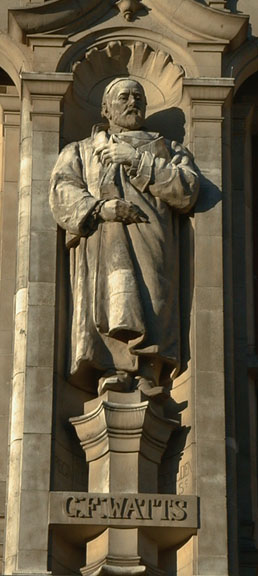Biography
G. F. Watts, façade of the Victoria and Albert Museum. London.
Born in London, son of a piano maker and tuner. Early enjoyed the run of thc studio of sculptor William Behnes. Entered R.A. Schools, 1835. Won premium of £300 with cartoon of "Caractacus" for Westminster Palace, 1842. Went to Italy, where befriended” by Lord and Lady Holland. Returned to England 1847. Became eminent portrait painter, but was more interested in allegorical subjects on monumental scale. Always admired Elgin marbles. Friend of Leighton from 1855, and like him (and many of the old masters) made small plaster models in preparation for compositions of paintings. Exhibited "Clytie" (a bust) at R.A. 1867. Life-size figure of Lord Holland seated, designed in collaboration with J. E. Boehm. Began colossal equestrian statue of Hugh Lupus, 1870, finished in 1881; repeated composition in "Physical Energy" posthumously erected in Kensington Gardens, 1908. A R.A. and R.A. 1897. — from British Sculpture, 1850-1914
Sculpture
- Clytie
- Lord Tennyson
- Physical Energy
- Final Version
- Reduced Version (17 inches)
- Reduced Version (22 inches)
- Plaster Study (large, detail, side view)
- Plaster Study (small, front view)
- Untitled [Seated Baby].

G. F. Watts by Henry Poole. Watts Gallery, Compton.
Works in Other Media
Watts as Subject — Portraits
- Bust by Sir Alfred Gilbert
- Statue” by Henry Poole
- Statue, façade of the Victoria and Albert Museum. London
- Bust by Emma Cadwallader-Guild
- Watts painting outdoors (photograph)
Bibliography
Beattie, Susan. The New Sculpture. New Haven: Yale University Press, 1983.
Blunt, Wilfred. "England's Michaelangelo": A Biography of George Frederic Watts, Om., R.A. London: Hamish Hamilton, 1975..
British Sculpture, 1850-1914. Exhibition catalogue, The Fine Art Society, 148 New Bond Street London Wl. 30th September-30th October 1968, no. 37.
Brown, Stephanie. "Indefinite expansion: Watts and the Physicality of Sculpture." in Representations of G.F. Watts: art making in Victorian culture. Ed. Colin Trodd and Stephanie Brown. Aldershot: Ashgate Publishing, 2004.
Gould, Veronica Franklin. G.F. Watts, the Last Great Victorian. New Haven: Uale University Press, 2004.
Read, Benedict. Victorian Sculpture. New Haven: Yale University Press, 1982.
Last modified 26 February 2020
